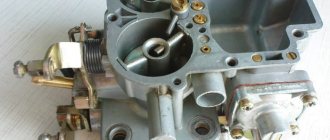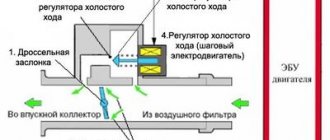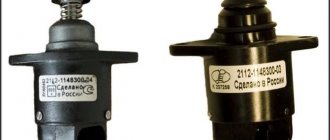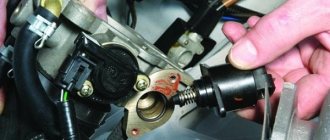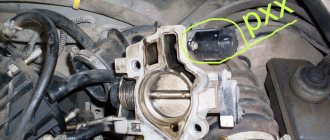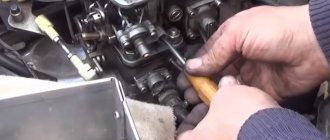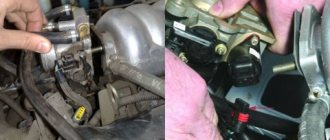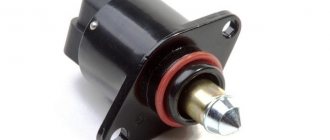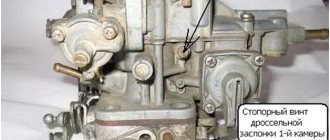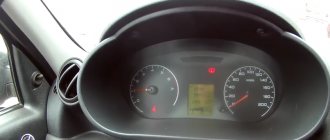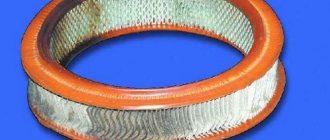07/09/2021 1,361 Fuel system
Author: Victor
Correct operation of the idle speed sensor allows you to reduce wear on the piston group, as well as the crankshaft of the car. If signs of incorrect operation of the device appear, the controller can be checked manually, with a multimeter or using a homemade stand.
[Hide]
Purpose of the idle speed sensor
Purpose of IAC in vehicles equipped with an electronic ignition system:
- The microprocessor module determines the ratio of air and fuel when creating the air-fuel mixture in the injection power unit.
- The control unit measures a certain volume of gasoline or diesel fuel.
- The electronic type of systems is equipped with controllers for the crankshaft, throttle position, knock and flow meter. In accordance with the readings of these devices, the fuel pump is activated. The ignition is distributed to specific cylinders of the internal combustion engine.
- If the driver releases the gas pedal, the fuel valve closes completely. This leads to the fact that the proportions of the combustible mixture are violated. Combustion products move into the chamber when there is a difference in pressure between the exhaust and intake manifolds.
The idle speed sensor in electronic ignition systems performs the function of adjusting the composition of the combustible mixture during engine starting. Using the signals sent by the controller, the microprocessor module makes a decision about fuel enrichment. In doing so, it ignores the readings sent by the throttle control. The sensor transmits signals along the line. If necessary, a free channel opens in it through which air passes. This leads to equalization of engine speed while driving or idling.
User Roman Lozovoy presented a detailed review of the controller from the manufacturer General Motors for the Daewoo Lanos.
Types of IAC malfunctions
To understand why such signs of malfunctions occur on Lanos when the idle air regulator fails, let’s look at the main types of mechanism malfunctions. Such breakdowns include:
- Slippage occurs when the worm gear of the stepper motor wears out. The result of slipping is manifested in the form of slipping of the needle valve, and the ECU cannot set the required number of steps
- Stuck - Often the needle valve becomes stuck in the closed position. The engine is working properly, but due to the fact that the valve is mechanically jammed, the operation of the internal combustion engine is impossible or possible, but intermittently
- Stepper motor malfunction - occurs when the stator winding breaks
- Air leakage - occurs if the sealing gasket is faulty or if it was not installed when installing the sensor
- The regulator falls apart - this is due to the rivets falling out, which leads to a malfunction of the device. This damage can be eliminated by making homemade rivets
All types of device malfunctions can be identified independently, for which there are various methods, discussed in detail below.
Principle of operation
The operating principle of the valve is as follows:
- The control unit calibrates the sensor readings if it is detected in the system.
- The controller itself is a stepper electric motor. It is equipped with a conical needle, which is located in a special hole in the throttle valve channel.
- The regulator does not transmit information to the microprocessor module, but receives it from it. Therefore, it is more correct to call it not a sensor, but an actuator - a valve.
- The control unit determines, based on a signal from the flow meter, that there is no air in the combustible mixture. It then compares these impulses with those transmitted by the TPS.
- The regulator device receives voltage. This causes the needle to move out of the canal. the missing volume of air is supplied to the combustible mixture for mixing.
The microprocessor module also receives pulses about the temperature level of the coolant and engine fluid. If the engine starts at low negative temperatures, it must be warmed up, which will reduce wear on friction elements and units. To enrich the mixture, the idle speed sensor channel opens slightly; for this, the driver does not need to press the gas.
At the beginning of the device operation, the action algorithm is as follows:
- The key turns in the lock and the ignition is activated.
- The rod extends all the way. Thanks to this, the needle closes the bypass channel.
- When the rod rests against the calibration hole, the control unit begins to count steps backward.
- Voltage is applied to the windings. As a result, the valve returns to its original open state.
The number of reverse steps is adjusted when flashing the control unit; this indicator may vary depending on the device model. For example, on a Bosch ECU it is 50 steps, and on January modules it is 120.
User Dmitry Shark spoke briefly about the principle of operation, as well as about diagnosing the idle speed controller.
Injector
A throttle valve is used at the input of the collector device in injection engines. It is equipped with an individual controller for determining the position at a specific point in time.
When the engine starts or the powertrain stops, the following occurs:
- The microprocessor module receives data on rotation speed.
- Then the control unit analyzes the operation of the power unit and specifies its intended purpose.
- Readings from the throttle controller and air are compared. The control unit determines whether the damper is closed or not. He can also “understand” which mixture is supplied to the cylinders of the power unit - lean or enriched.
- The IAC valve opens. The air flow bypasses the damper. This makes it possible to maintain speed at a certain level, programmed in advance.
In fact, several ignition system devices are involved in this process. If the car engine stops or stalls due to problems, the operation is checked manually. This is due to the fact that there is no feedback from the IAC and the diagnostic system.
Diesel power units are not equipped with a throttle valve, so they do not use idle speed sensors, they are useless.
User Alex ZW spoke in detail about the principle of operation of the IAC controller in a car.
Calibrating a new IAC
What should I do if the test reveals that the sensor needs to be replaced? It needs to be calibrated.
- We check the distance from the end of the rod to the mounting plate, it should be no more than 23mm.
- We disconnect the minus from the battery, de-energizing the ECU.
- Install the regulator.
- We connect the battery back.
- Turn on the ignition for 5 seconds without starting the engine. At this time, the IAC calibration occurs.
- Turn off the ignition to complete the calibration.
- We start the engine and observe the idle speed.
Now you know how the idle air regulator works, how to check it and, if necessary, replace it. As you understand, there is nothing complicated about this and all operations are accessible even to a novice car enthusiast.
Finally, a video about diagnosing IAC:
Source
Design features
The valve structurally consists of:
- electric stepper motor;
- four-position rod;
- spring element;
- needles.
When IACs first appeared, they were rotary or solenoid mechanisms. Such devices had two positions - open and closed. This contributed to a decrease in the efficiency of engine speed control. Today, cars use four-step sensors, characterized by the possibility of stepwise feed through the bypass.
The idle air control itself is classified as a consumable item and is therefore considered non-repairable. It can be repaired if it malfunctions, but it will be cheaper to replace it completely.
Where is RXX located?
The device should be located next to the throttle valve and TPS. In some cars, the sensor can be fixed directly to the damper body using varnish. Sometimes the device is mounted using two bolts equipped with special mounting holes. The main thing is that the distance from the needle to the mounting flange on the installed device is 2.3 cm.
Connection diagram
Idle air controller connection diagram
One harness consisting of four cables is connected to the idle speed sensor; it comes from the microprocessor module. As a result of this connection, diagnostics may cause certain difficulties. The car owner will not be able to simply apply voltage to the terminals of the device, since the microprocessor module does this pulsed.
Conclusion
The idle air control is a small component of the throttle body that does a very serious job. Thanks to the regulator, the car engine does not require a long warm-up and runs well at idle. The approach to idle control has changed significantly over the past 10-15 years. Electronic throttle valves, which do not require a regulator, are becoming increasingly popular, since the valve itself copes with its tasks. Such chokes are not afraid of low temperatures and mechanical failure, since there is practically none. As for cars with classic engine throttle valves, choosing the appropriate regulators today is quite simple. They will be released for a very long time.
Signs of incorrect IAC operation
Symptoms of a regulator failure in a car:
- The car engine stopped running. When driving or standing at a traffic light, the speed of the power unit can arbitrarily increase or fall, and then return to normal. They may freeze.
- The car's engine began to idle. Detonation is heard - a metallic knock from under the hood.
- While driving, there is no compensation for the increased load on the car's engine.
- Difficulties arose in starting the power unit. If the driver has to press the gas additionally when starting, this indicates wear and the need to replace the idle speed sensor.
- Warm-up speed is absent or maintained at an insufficient level.
- The car engine may randomly stall for no apparent reason. This occurs when idling, releasing the gas pedal, or shifting the transmission lever.
- The crankshaft speed may drop randomly when energy consumers are activated. For example, air conditioning or heating systems, windshield wipers, optics, etc.
Operating principle of IAC
The sensor installed on the engine (mass air flow sensor) determines the volume of incoming air and sends a signal to the ECU, which “gives a command” to “send” the required amount of fuel to the injectors. At the same time, the control unit takes readings from the crankshaft position sensor and controls the operation of the IAC. The last action is expressed in issuing a “command” to open an additional channel.
Another function of the IAC is to adjust the idle speed (700-900 per minute) depending on the engine warming up. If the temperature is insufficient, the ECU “orders” the sensor to increase the passage of the channel: as a result, more air enters the combustion chamber, and the control unit simultaneously supplies more fuel - as a result, the speed increases and the power unit warms up faster. In the same way, using IAC, the ECU takes into account changes in the load on the engine associated with the connection of additional consumers: for example, headlights, interior heater, heated rear window, mirrors, seats, etc. As a result, the engine operates stably at any load.
Main breakdowns and malfunctions of IAC
Causes of problems with the idle speed sensor:
- Power supply circuit interrupted. This malfunction may be related to the wiring in the car, oxidation or damage to the contact elements on the block. If the connection is of poor quality, then this problem will appear periodically. It may be difficult to diagnose the device.
- Contamination of the rod, which leads to its incorrect movement. This problem is the most common and manifests itself as a result of the accumulation of dirt deposits in the channels of the throttle assembly. If the damper is not cleaned for a long time, then the reason should be looked for on the sensor rod.
- Failure of the electric motor. It is unlikely that such a device will be repaired; the engine must be replaced as an assembly with the regulator.
- Destruction of the sealing element due to wear. The problem may appear immediately after replacing the sensor if an old ring is installed instead of a new one.
- Rod wear. If the regulator is working properly, then the shutter should move without snagging, and slipping in the worm gears is not allowed. To determine the condition of the structural elements, you will have to disassemble the device.
The channel “Sdelaj Sam!” spoke about the causes and signs of malfunctions in the idle air valve! Pljus interesnoe!
Inspection and repair
As mentioned above, if your car's throttle body is protected by a casing, getting to the regulator may not be easy. Before starting the test, we advise you to study this unit and also check the integrity of the wiring. An important point: further checking of the regulator cannot be carried out correctly with a discharged battery. If there are no problems with all this, then you can start checking. There are several methods:
- Check the resistance between the windings. Between C and B , as well as A and D, there must be an open circuit (infinite resistance). But between A and B , C and D, the resistance should be from 30 to 100 Ohms;
- Checking with a homemade tester. 6V AC transformer . Armed with such a tester, you will need to check whether the regulator rod moves normally. Some car enthusiasts simply lightly press their finger against the end of the rod and try to understand whether the rod moves.
Let us immediately note that if the elements of the sensor “filling” fail, the entire device will have to be replaced - it is not repairable. However, some manipulations can solve the problem at least temporarily. So, for example, if you checked the regulator using the second method and made sure that the rod stopped moving, do the following:
- Wedge the regulator with silicone grease. If it gets inside the device, there will be no consequences;
- If lubrication does not help, soak the stem in alcohol and wipe with a cotton swab. Alcohol can also replace carburetor cleaner;
- If the above cleaning products are ineffective, use WD-40. This is an extremely aggressive product that should be used last.
If cleaning the regulator does not produce results, you will have to buy a new device . A car enthusiast can disassemble it and try to identify the cause of the breakdown. In most cases, the regulator stops working properly if the guide cone needle is unusable (wedge, abrasion, deformation).
Diagnostics
Before checking the operation of the controller, perform the following steps:
- The parking brake lever is tightened. Wheel chocks must be placed under the wheels of the vehicle.
- The engine compartment of the car is opened and the negative terminal is disconnected from the battery. To do this, use a key to loosen the fastener on the lock.
- The engine compartment is being inspected. You need to find the idle air control.
- The block with the wire is disconnected from the device.
Manual check
This diagnostic stage is considered the simplest in terms of implementation:
- The block with wires is disconnected from the device.
- Two bolts are unscrewed and the regulator is removed.
- The sensor is connected to the microprocessor unit. The controller must be held in your hands.
- The engine is being started, it is advisable that an assistant do this. At this point, the rod should be pulled into the coil all the way. This occurs as a result of receiving an impulse from the control unit. Then it should move out a short distance.
Manually checking the idle air control valve allows you to determine the functionality of the rod. When performing this, you can make sure that the part does not bend or jam inside the device.
But this verification option does not give a 100% result. It is possible that the modification of the idle speed sensor installed on the vehicle does not match the firmware of the microprocessor unit. The rod extends, but the required amount for its extension is unknown. Therefore, the block and plug are checked, and only the latter is marked.
During a visual inspection, it is necessary to diagnose the integrity of electrical circuits and coils. You should also check the condition of the bypass channel and needle for wear.
User Igor Belov spoke in detail about performing a manual check, as well as other methods of testing the idle air valve.
Diagnostics with a multimeter
You can check the operation of the controller using the tester like this:
- The connector with the wire is disconnected from the regulator in the engine compartment. If the car is equipped with a 1.6 liter engine, then it is necessary to unscrew the two fastenings of the throttle mechanism to the receiver in advance. Then it moves away from the end of the latter by about 1 cm.
- First, the tester diagnoses the controller's electrical circuit to make sure whether voltage is supplied to it or not. The negative terminal of the multimeter is connected to ground, that is, the body or engine of the car. The positive contact should be connected to pins A and D, they are marked on the connector.
- The ignition is activated and the tester readings are read. The multimeter must first be set to ohmmeter operating mode. The resulting voltage value should be at least 12 volts. If this parameter is lower, then there is a possibility that the problem is a low battery. In the event of a complete lack of power, you must ensure the integrity of the electrical circuit or control unit.
- The ignition is turned off. The next step will be diagnosing the controller itself.
- The multimeter is reconfigured into resistance measurement mode, its terminals are alternately connected to contacts A and B, and then to C and D. The resulting diagnostic value should be about 53 Ohms.
- Then the resistance is measured between pairs A and C, as well as B and D. On them, the working value should tend to infinity. If the values obtained are different, the sensor must be replaced.
Pulse testing on a homemade stand
You can assemble a homemade device without chips; its diagram is shown below:
- The equipment uses 6 volt charging. It can be taken from a mobile phone.
- Connector pads can be purchased at any specialty store.
- During diagnostics, the sensor is first disconnected from the microprocessor module. The rod stroke is checked. If the light indicator of a homemade stand lights up brightly, this indicates that the regulator rod is faulty. If the light is on at half power, then the mechanism is working.
Scheme of a simple homemade diagnostic stand
The price of such equipment is at least 1,500 rubles. Considering the low cost of the idle speed sensor, using a proprietary stand is not economically profitable.
Sensor diagnostic methods
The easiest way to check that the idle speed sensor is working is to start the engine and remove the power connector from the block. When the element is in good condition, the speed will drop sharply and the engine will stop - when the power supply is turned off, the spring will push the cone forward and the cross-section of the bypass channel will completely close. If the engine operation remains the same or changes slightly, move on to other testing methods.
The next stage of diagnostics is measuring the supply voltage, performed in this order:
- Disconnect the IAC connector and turn on the ignition.
- Using a voltmeter, measure the voltage at the corresponding contacts of the removed connector (in VAZ cars these are terminals marked A and D).
- If there is no voltage or does not reach 12 volts, you need to look for a problem in the electrical wiring. Otherwise, proceed to diagnosing the regulator itself.
Basically, on cars, you can check the performance of the stepper motor without removing it from the car. Using a multimeter, measure the resistance between the following pairs of contacts: A - B, C - D (it should be approximately 53 ohms). Then measure other pairs - A - C, B - D, on a working regulator the device will show infinity.
Further checking of the idle speed sensor is carried out as follows:
- Disconnect the power supply, unscrew the mounting screws and remove the element from the throttle valve block.
- To prevent contamination of the rod, clean the cone and spring with a soft-bristled brush, using kerosene, diesel fuel, or better yet, carburetor cleaning fluid. Do not use acetone or solvents like 646 - they will destroy the plastic.
- Blow through the cleaned part and connect the connector.
- Place your finger on the rod and ask an assistant to turn on the ignition. The cone of a functioning regulator should move noticeably. If nothing happens, feel free to change the sensor.
Advice. If a strong oil deposit is detected on the working part of the IAC, it is highly advisable to perform the procedure for cleaning the throttle and bypass channel - a similar picture is likely to be observed there.
To install a new regulator, be sure to remove the negative terminal of the battery. After assembly and connection, the IAC controller is calibrated - you need to turn on the ignition and wait 15 seconds. If the battery is not disconnected, the ECU will skip the calibration step, which may cause the engine to run unstably.
Source
How to clean the idle air control?
Cleaning a proven IAC is considered using the example of a Chevrolet Niva:
- The engine compartment is opened and the battery is disconnected. To do this, you need to dismantle the cover of the air filter device, which is removed and put aside.
- The block is disconnected from the air controller. The connector is located on a thick rubberized corrugation connecting the intake manifold and the air filter cover. This block is attached using a special U-shaped bracket. During dismantling, it may jump out, so you need to be careful.
- Then the corrugation is disconnected from the intake manifold, it is fixed with a clamp. The same must be done with the rubberized pipe; it connects the corrugation to the valve cover of the power unit. The hose is fixed with an iron bracket.
- The thin pipe connected to the intake manifold is disconnected and removed along with it. This hose is pulled onto the fitting.
- Inside the pipes you can notice contamination in the form of carbon deposits and traces of engine fluid. All hoses must be cleaned and washed, after which they must be blown out. To complete the task, it is recommended to use a special cleaning agent or WD-40 liquid. The main thing is that there is a tube included with the cylinder.
- The idle speed sensor itself is made in a black plastic case and is installed in the intake manifold. The plug is disconnected from it and the two bolts that secure the device are unscrewed. The procedure is performed using a short screwdriver with a Phillips head; first, traces of sealant must be removed from the bolts. When dismantling the device, you must also remove the O-ring.
- The IAC is being cleaned, and fuel can also be used for this. The procedure is carried out using rags and cotton swabs. You cannot pour a lot of liquid into the mechanism so as not to damage it. After each cleaning, the sensor should oxidize and dry.
- It is recommended to remove dirt from the intake manifold; dirt is removed using rags. The idle speed sensor seat is cleaned throughout its entire depth. Contaminants are also removed from the device fitting.
- After cleaning, the entire structure is reassembled in the reverse order. A new rubber ring is installed on the idle speed sensor, after which the controller is mounted in place and fixed. The connector is connected to it, and the air filter device is installed back.
Dismantled corrugation with hoses
Removing the IAC from the seat
Cleaning the sensor with WD-40
What is the best idle air control regulator to install on Lanos and are analogues from Sens suitable?
Having understood the design, the principle of operation of the DHC on Lanos, as well as its diagnostics, cleaning, testing and replacement, it remains to find out which regulator is best to install on Lanos, and how much it costs.
Initially, it should be noted that the regulator for Lanos is different from the device for Sens and Chance. The difference lies in the design of the needle valve. For SENS, Chance and Tavria cars, which are equipped with Melitopol engines, original sensors are not available. These cars should be equipped with regulators from the VAZ 2112. The best manufacturer of these devices is.
For Chevrolet Lanos cars, original Korean-made devices are produced. Finding an original GM sensor (part number 17059602/93744675) is quite difficult, so you should choose regulators from Continental, LCC, Delphi, CRB and others. Their approximate cost is about 1000 rubles. It is possible to install a regulator from a Chevrolet Niva on Lanos, since the differences between them are only in the location of the socket for connecting the chip with wires. Idle speed sensors РХХ 21203-1148300 are installed on Lanos. The photo below shows the regulators for Sens and Chances (on the left) and for Lanos (on the right). The photo shows that they differ in the design of the needle valve.
Having understood in detail the question of what the idle speed control on Lanos is, what it is needed for, and how to check it, it remains to summarize and note the following that the element in question certainly plays a very important role. Its malfunction disables the car engine, so it is very important to ensure that the sensor is always in good working order. How to check, repair and replace it on Lanos, Sense and Chance is analyzed in detail in the material.
Photos partially used from drive2.ru
What do you need to know when replacing the IAC?
To change and install a controller that allows you to regulate idle speed, you need to pay attention to the position of the rod. It must not be allowed to be pushed forward too much. This can happen if the device is connected to the block and the ignition is activated before installation. It is not allowed to push the rod in by hand.
If the valve is installed with the needle extended and the retaining screws are tightened, damage to the unit may occur due to shearing of the worm gear. It is impossible to repair such a sensor. Depending on the vehicle model, after installing a new regulator, it may need to be calibrated. In some cars, this procedure is carried out using special equipment or a stand.
On VAZ cars, calibration is performed as follows:
- A terminal is connected to the negative output of the battery.
- The key is turned in the lock to turn on the ignition for ten seconds. There is no need to start the power unit.
- The ignition is turned off.
User Ovsyuk talked about replacing the idle air valve on his own using the example of a Lada Samara car.
Sensor diagnostics
You can check the idle air valve yourself. Its faults can be divided into two parts: mechanical and electrical. There are several verification methods.
Visual inspection
First you need to conduct a visual inspection. In this way, you can detect body defects, needle wear, and carbon deposits. If deposits form, you can clean them with carburetor cleaner. It is also recommended to clean the entire throttle body as it is in a similar condition.
Using diagnostic programs
The operation of the IAC can be checked using a diagnostic adapter and special programs. For example, you can use the simplest ELM327 adapter and the OpenDiagMobile program. In the program menu you need to select the desired position of the XX regulator and watch the operation of the valve. It is better to set it at least 20 steps more than the current position.
Wiring check
For this we need a multimeter. With the engine off, remove the connector from the sensor. We set the measurement limit on the measuring device to 0-20 V DC voltage. We measure the voltage at the connector. Normally it should be 12V.
Checking the regulator resistance
To do this, we will need to measure the resistance between terminals A, B, and C and D after disconnecting the sensor terminal. We move the multimeter to the position of measuring resistance at the limit of 0-200 Ohms (Ω).
The normal value is within 50-55 Ohms. The resistance between A and C, B and D must be infinity.
Checking with throttle assembly
There is another way to diagnose IAC. To do this, you will need to remove the throttle assembly from the studs along with the sensor.
By connecting the valve connector and turning the ignition on/off, you can observe the operation of the IAC live. See how the needle works, if it is rubbing somewhere, check the evenness of the stroke, hear suspicious sounds.
Tips for extending the service life of IACs
To increase the service life of the sensor, you need to follow simple rules:
- The air filter device must be replaced on time.
- You cannot park your vehicle for long periods of time in winter. At low negative temperatures, the car owner must periodically start the power unit, warm it up and perform gas changes. This will allow the valve to be designed to prevent it from sticking.
- Do not allow foreign liquids to enter the throttle mechanism area. Sprays for quick starting of the engine usually do not pose a danger to the sensor, but it is better not to overdo it.
The principle of operation of the regulator on Lanos
The regulator is popularly called a check or bypass valve, the purpose of which many drivers do not fully appreciate. This device is called a check valve because excess fuel pressure is drained back into the tank. To understand the principle of operation of a part, you will need to imagine its internal structure. The fuel regulator diagram is shown in the photo below.
Having a visual idea of the design of the RTD, let’s consider the features of its functioning. The device is divided into two parts or chambers - fuel and vacuum (they are also called spring or diaphragm). The flow membrane is located inside between the vacuum and fuel cavities, and reacts to the pressure of fuel and air in the manifold. The fuel chamber is filled with gasoline under high pressure.
The operation of the RTD begins after the ignition is turned on, when the pump pumps fuel from the tank into the main line. Fuel initially enters the ramp, and then into the device through a special inlet channel (connection to the ramp). When the fuel chamber is filled with fuel, the membrane is pushed. On the other side (the vacuum chamber), the membrane is pressed by a spring and the pressure of the intake manifold (connected using a hose). When the fuel pressure in the regulator chamber is higher than the spring force, the membrane moves and the valve opens. Through the opening valve, excess fuel flows through the channel back into the tank through the “return” channel.
The pressure regulator operates not only from excess fuel pressure pumped by the fuel pump, but also due to engine vacuum, that is, when the load increases or decreases. When the load on the internal combustion engine increases, the vacuum decreases (the absolute pressure increases under the load of the internal combustion engine and puts pressure on the membrane), and the valve closes, increasing the fuel pressure in the system. If the load on the engine increases (for example, when moving up), then the fuel pressure in the system increases, which is due to an increase in fuel consumption.
When the vacuum increases (absolute pressure drops as the load decreases), the valve opens by displacing the membrane, thereby releasing excess fuel returning to the tank.
This is interesting!
In simple terms, the RTD ensures balancing of the fuel pressure supplied to the injectors at different engine loads.
Nuances of choosing a sensor
The original idle speed controller is marked as XX-XXXXXXXX-XX. The last two characters define the compatibility label.
More details about them:
- odd characters (03 and 01) are interchangeable, as are even characters (04 and 02);
- device group data cannot be replaced, that is, even ones cannot be replaced with odd ones.
You can identify a fake low-quality idle speed sensor by several criteria:
- there are no distinctive marks on the device packaging;
- the tip of the rod has a dark shade;
- the yellow sticker on the device body has no frame;
- original sensors are equipped with a thin black seal, while counterfeits are equipped with a thick red ring;
- the body of a low-quality device will be 1 cm shorter;
- non-original sensors are equipped with a white spring instead of a black one, its turns are sparser;
- There are no caps with a diameter of 3 mm on the case rivets.
Signs of a malfunctioning idle speed control on Lanos
The device in question has a fairly long service life, but the time comes when the regulator needs to be replaced. First, let's look at the question of how to understand that the sensor is faulty and needs to be diagnosed. The main signs when a driver should pay attention to IAC appear in the following ways:
- Problem starting the engine - if the valve is stuck in the closed position, it is almost impossible to start the engine
- When starting the engine, there is a “floating” of revolutions - an increase or decrease
- Long engine warm-up
- The engine stalls when the gearshift lever is moved to neutral
- After starting a cooled engine, the idle speed does not increase to warm up
- When the electrical circuit is loaded, a decrease in speed is observed
This is interesting!
All of the above symptoms appear due to the fact that there is not enough air at XX or it is supplied in excess.
The most common symptoms that force the car owner to check the serviceability of the IAC are when difficulties arise in starting the engine, as well as when the engine stalls when the speed is turned off. If all of the above symptoms occur, the sensor should be checked immediately. How to determine that the idle speed sensor on a Lanos is faulty will be discussed in the next section.
Video “Self-calibration and removal of the rod from the IAC”
User Ruslan K talked about how to remove the needle from the regulator at home and calibrate it without special equipment.
Do you have any questions? Specialists and readers of the AUTODVIG website will help you ask a question
Was this article helpful?
Thank you for your opinion!
The article was useful. Please share the information with your friends.
Yes (100.00%)
No
X
Please write what is wrong and leave recommendations on the article
Cancel reply
Rate this article: ( 2 votes, average: 5.00 out of 5)
Discuss the article:
